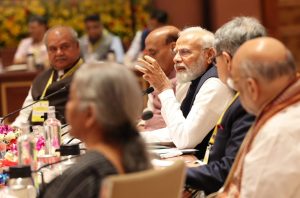India’s G20 Presidency and challenges

Photo Credit Twitter The Constructor
By Rahul Kumar Dubey
New Delhi, August 17: Holding the G20 Presidentship, India will have chances to share its knowledge, experience and renewable energy products with countries across the globe, having already achieved its target of 40 per cent of its installed energy capacity from non-fossil energy sources. This will encourage international collaboration on energy transformation during India’s next G20 chairmanship.
The G20 is by far the most significant platform for regional cooperation and plays a vital role in world economy. This time, all eyes are on India to address a wide variety of concerns such as the nation’s conflict, rising global inflation, food and energy crisis, and so on. One arena in which India can lead the world is energy security.
The conflict between Russia and Ukraine has exerted a profound influence on the global energy dynamics, destabilizing both demand and supply trends and shattering prevalent trading partnerships. \
Energy prices have soared across spectrum, be it consumers, domestic household, industries, and every other sector.
This is also evident for developing nations where people have the least financial means to pay for it. Additionally, it poses a risk of derailing attempts to address the urgent problem of cutting greenhouse gas emissions globally and swiftly enough to prevent catastrophic climate change.
In its role as G20 President, India must prevent energy security from falling prey to yet another regional dispute.
The rest of the world is taking lessons from Russia that despite the possibility that sanctions on it could have an effect on its economy for a short duration, such measures are bound to fail in the long run.
The European countries that depend on gas are most at risk from Russia’s response. The gas scarcity in nations like Germany will take a different turn in November, as the needs of their energy will soar up.
The heated virtue-signalling economics prevalent in the EU is bound to change its course in the coming winter owing to significant energy demand, but more significantly, the unwelcome frigid politics of Europe will disintegrate as the time will pass by.
By placing the blame elsewhere, like the West and the EU tried to do with India, for importing statistically considerable amounts of oil from Russia, the West’s duplicity was exposed.
On this front, India needs to bring different G20 energy interests together on a functional platform, namely energy producers who happens to be the US, Russia, and Saudi Arabia vs energy consumers, like Europe and the rest of the global community.
Currently, the first global energy crisis is occurring. In the 1970s, it was the oil crisis, while today, it’s the coal, natural gas, and oil crises, wherein their costs are increasing, and many countries are emphasizing energy security.
Due to the presence of representatives from significant energy producers, the Indian Presidency will present a forum for discussion on the current high oil and gas prices, while shifting the sources of energy to renewable energy sources.
The achievements that India have achieved over the span of last eight years is not only remarkable, but also a case study for the global community to follow and incorporate in their sustainable development goals for their energy security. For instance
- India’s solar capacity increased from 2.6 Giga Watts to more than 46 Giga Watts in the last 7.5 years.
- The World’s largest Renewable Energy Expansion Programme of 175 Giga Watts will take place till 2022.
- Till date, Renewable Energy has a share of 40.1 % in the total installed generation capacity in the country.
- India is now at 4th global position for overall installed renewable energy capacity.
- Solar power tariff in the country is reduced by more than 75% using plug and play model.
- About 19 times higher solar pumps installed between 2014-19, which happens to be 2.25 lakh versus upto 2014 – 11,626.
- Renewable energy installed capacity in India have increased 286% in last 7.5 years, which the world shall take lessons from.
- Solar Park scheme doubled from 20 Giga Watts to 40 Giga Watts.
- Record low solar tariff Rs 1.99/unit achieved.
- Highest ever wind capacity addition of 5.5 Giga Watts in 2016-2017.
For both India and the International Renewable Energy Agency, the presidency is a fantastic chance to investigate and collaborate on how renewable energy may speed up industrial change in difficult-to-abate industries.
Mani Bhushan Jha, Programme Associate with World Resources Institute India Climate Program stated that “with one of the lowest solar tariffs in the world, India has taken a significant lead in Solar energy solutions”.
“It is expected that India will use its G20 presidency to build partnerships and leverage the existing ones to influence nations by showcasing its comprehensive approach to renewable energy development. It can also envision making use of its affordable solar technologies and supplying it to other developing nations which can help accelerate the global energy transition. During its G20 presidency, India can further champion its existing leadership through the International Solar Alliance and initiatives of GGI-OSOWOG to advocate for enhanced access to climate finance for emerging economies to ensure a just and equitable energy transition,” Jha added.
(Author is a researcher with Public Policy Research Centre)







